WRITING & HYPERTEXT: More Marathon Produce
This in, a link to what Steve Ersinghaus had spent 24 hours working on at the Tunxis Art Marathon.
This in, a link to what Steve Ersinghaus had spent 24 hours working on at the Tunxis Art Marathon.
Here’s the latest version of Literary Endeavors, with the Poems set up and the Print Journals transferred from a Container to an Adornment. Couple things learned the hard way: If you overlap an Adornment onto another, you’ve got a holy mess on your hands because they become attached and move together, leaving the notes behind. Worked my way out of it, but not a happy sight as you move things around and the situation gets worse. But that’s what the “Save” feature is for.
Obviously, planning ahead for size when you want something that needs to all be displayed at once (another reason for keeping them out of Containers and using Adornments) is an important point. Particularly when you know you will be adding lots of notes on an adornment. I should have minimized the view right away and spread the Adornments to fit at that point, geared towards a horizontal screen.
As far as links, all I have so far is the (blush!) published ones in so far but I’m planning for the submitted and accepted/rejected return links as soon as I resize my layout.
That’s one of the problems with self-teaching: you learn something the wrong way and once you stumble across the right way, you have a lot of changes to make. On the other hand, a lesson learned from trial and error is one that sticks with you–especially if you have quite a bit of work done to date.
Once I realized that the thing I wanted was an Adornment and not another Container Note, I had to transfer a whole lot of notes into different areas. Thankfully, I didn’t have all the stories, hypertext or regular, and only two of the poems so far entered into the program. I do have about 80 of the print journal notes made, but few of the online journals and just a couple of the new media. It was a case of trying to fill in spaces from memory in some cases, just to have a few samples to work with. At any rate, here’s the first step towards redesigning the Literary Endeavors Tinderbox file.
It was demoralizing. It was one of those questions that your knowledge and experience with the program should have taken you beyond. It was something I felt too embarrassed about not knowing to bring me to ask. Why was everybody else’s map so different from mine? Why wouldn’t my notes show up with titles? Why wouldn’t my links transcend their corrals?
The Answer: I was using Containers, while they were using Adornments. A tweet from Mark Bernstein along with the alert that though it was in German, it was a great visual, led me to this site by Felix Dencker, where I not only noticed that the Germans also knew something I didn’t, I picked up the word “Adornment,” within the article and voila’!
An image of the updated file “Literary Endeavors” (previous post image):
With the generous assistance of Steve Ersinghaus, I finally was able to figure out exactly how to make use of the Tinderbox features of using prototypes and particularly, the agents. This was vital to this project as the different types of works wanted to also be separated for easy identification of word count and eventually, published, in submission process, etc.
Once I learned what to put in the query strings and where to put them into the agent note, I can take it further on my own into the specific areas for whatever purpose I need. I also learned that the prototypes must be specific and no note can serve two masters/prototypes so that if I want a group to follow a chocolate/blue dress (example only) standard, I need to make that a single prototype rather than two; likewise, chocolate/pink dress would be a different prototype entirely.
I’ve made a lot of progress on this particular project, and also can apply that knowledge learned last night into the 100 Hypertext project that I’d started late last year.
Now, I’m having fun.
Finally got around to some attempt at organizing my literary endeavors into some semblance of order with Tinderbox.
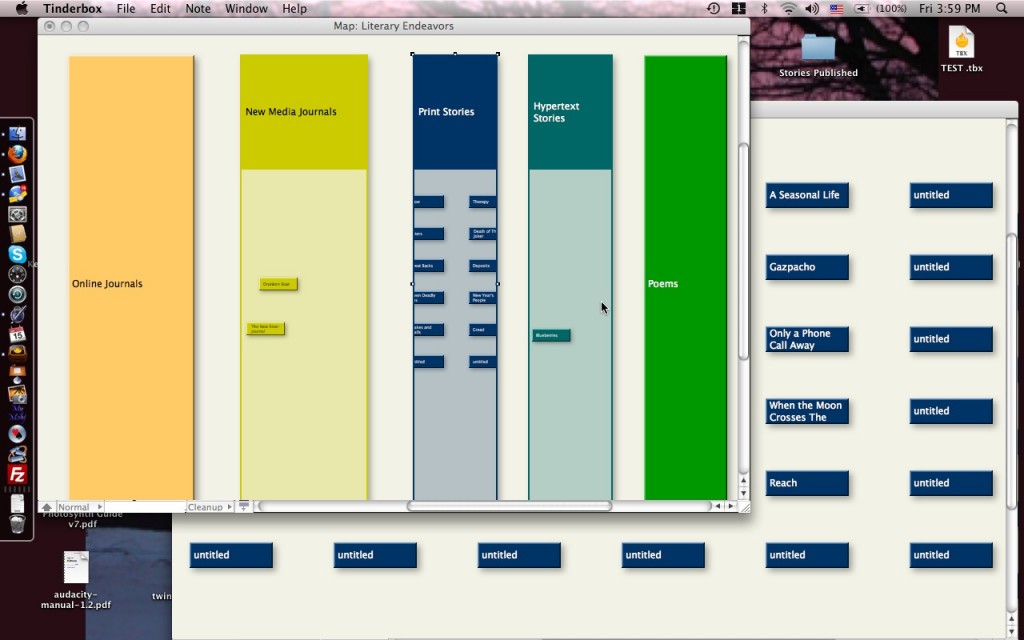 What I’ve come up with so far is a file called “Literary Endeavors” with containers labeled “Print Journals”, “Online Journals”, “New Media Journals”, and three more labeled “Print Stories”, “Hypertext”, and “Poetry”.
What I’ve come up with so far is a file called “Literary Endeavors” with containers labeled “Print Journals”, “Online Journals”, “New Media Journals”, and three more labeled “Print Stories”, “Hypertext”, and “Poetry”.
In the “Print Stories” container I’ve got notes for each of the stories I’ve written and within each will be the word count, genre, and maybe a separate note within each for where they’ve been submitted. Maybe all will be separate, so that they can easily be brought up according to genre, or word count or whatever since that will align with many publishing restrictions. The same format will be done with Poetry and Hypertext.
In the three main categories of journals, I’ll likely put in a note for which stories have been submitted and the dates of acceptance (Yay!) or rejection (Boo.).
This looks like a fun project to do between writing bouts and will prove invaluable now that I is a published writer.
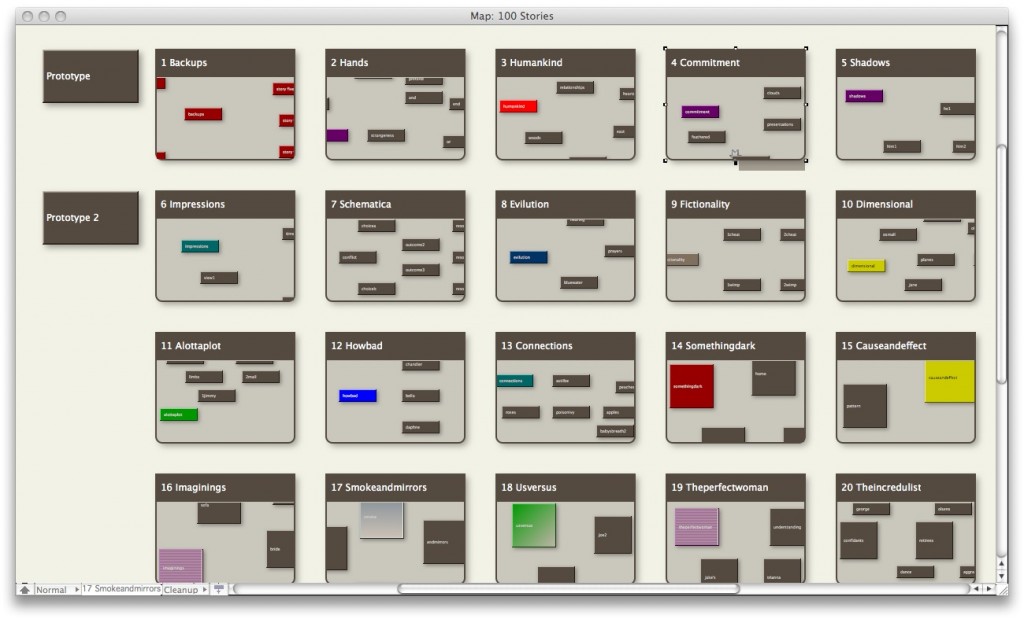
This is something I’ve wanted to do since I’d started the hypertext stories for the 100 day project and just never got time to spend to learn the full scope of the Tinderbox software and write some type of story too.
Right now, I’m putting the stories, which were each individually written in a Tinderbox file, into a Tinderbox 100 Stories File, hoping to eventually find out if they can be easily exported into html individually which was what I had to do with the stories being written and put online at the rate of one per day through this past summer.
There are things that I’d like to do with the project that would tie the individual stories into each other–some are actually serialized–and this compilation into one Tinderbox file would be the way to achieve that. In the image above, there are only twenty of the 100 hypertexts entered. I want to see exactly how they relate to each other before I put in the rest, make sure I can export each individually, and make use of some of the Tinderbox features. I’ve already created prototypes and some common attributes and there are some other delights to discover.
And yes, maybe I’ll even break out of my grid-form once I feel more comfortable.
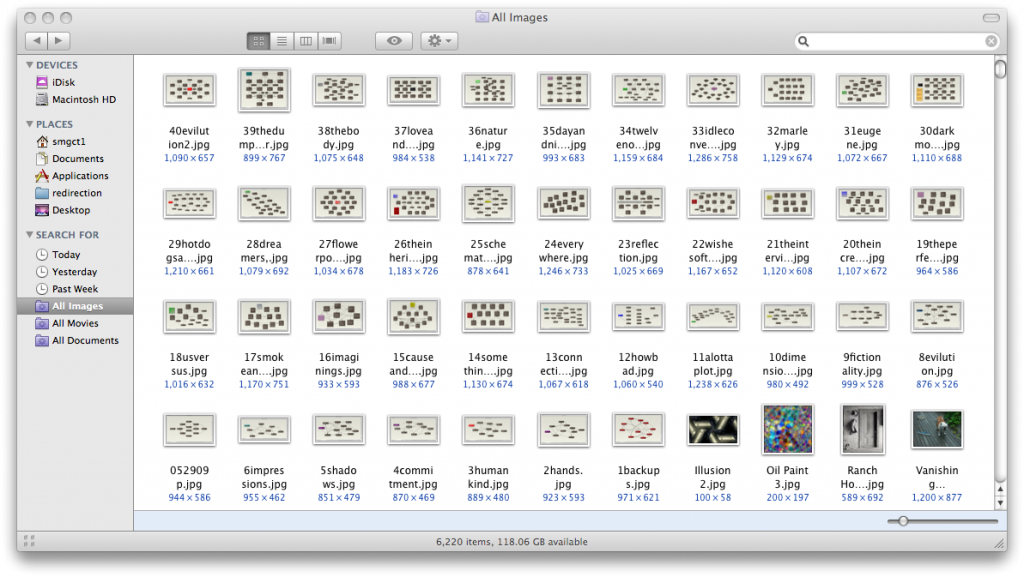 In looking for a particular image in my files this morning this greeted me–a whole buncha Tinderbox maps for the project. For one thing, you can tell I’m a person that is pretty rigid with structure, at least in mapping. I like symmetry. Oh, I have round days and rectangle days, but there seems to be a good balance between them.
In looking for a particular image in my files this morning this greeted me–a whole buncha Tinderbox maps for the project. For one thing, you can tell I’m a person that is pretty rigid with structure, at least in mapping. I like symmetry. Oh, I have round days and rectangle days, but there seems to be a good balance between them.
There appears to be a pattern of growth in the sophistication of the mapping as far as number of lexias and links. Maybe by #7 I got my act together and the maps took on a geometric form. Stories and maps elaborated into an attempt at visual as well as textual art. These are short short stories though, and I doubt I could get away with these maps in a larger piece without nesting them into a hierarchy. To the writer unfamiliar with hypertext the mapping of each story might look a bit scary; to the hypertextually experienced, these are child’s play. To me, it’s a nice visual to convince me that all this effort’s been worth some accomplishment.
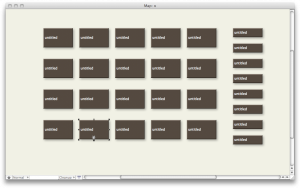 It’s day #35 and I’m up five days on css and html templates and even, yes the Tinderbox maps. Through a series of folders and organization I have these four files in “x” files (neat, eh?) as preparation for stories: 100column.css; 100column.html; titlec.html; x.tbx — though of course named x through x8 (some aren’t colorized yet)
It’s day #35 and I’m up five days on css and html templates and even, yes the Tinderbox maps. Through a series of folders and organization I have these four files in “x” files (neat, eh?) as preparation for stories: 100column.css; 100column.html; titlec.html; x.tbx — though of course named x through x8 (some aren’t colorized yet)
Tinderbox is a godsend in this project as the base camp for creating the hypertext story. While there is no rule as to what format I’m following or how many writing spaces I’ll be using, it is easy enough to change according to what I’m guessing the story will ask of me to lay it out. Some want circles. Some want squares. Some want organization and some want nothing to do with me.
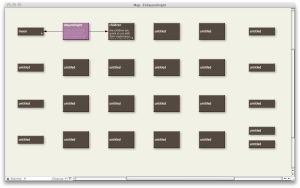 The first illustration is of the basic map, guessing that I’ll average 16 spaces, maybe more, maybe less; that I’ve been using a different sized box as “policemen” or traffic controllers or asides; that there needs to be room to maneuver and clearly show links when I’m first starting out with the story (sometimes I link everything as I’m writing it, sometimes I link just the main thread and hook up the rest later, sometimes I just sit and stare); and that the empty boxes are a lure (or a kick in the pants) to move on.
The first illustration is of the basic map, guessing that I’ll average 16 spaces, maybe more, maybe less; that I’ve been using a different sized box as “policemen” or traffic controllers or asides; that there needs to be room to maneuver and clearly show links when I’m first starting out with the story (sometimes I link everything as I’m writing it, sometimes I link just the main thread and hook up the rest later, sometimes I just sit and stare); and that the empty boxes are a lure (or a kick in the pants) to move on.
All this just helps me keep focused, something to play with in between bolts of brilliance (I play a lot) so that I don’t wander off to the garden or into the clutches of Tai Pei. The second illustration has been rearranged a bit to suit what I think is a prose piece that wants some structure to its life. We’ll see.
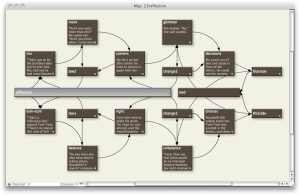 The question Steve posed in his story is an intriguing one that opens doors to all manner of theory. Since hypertext story #17 Smoke and Mirrors involved past and present hidden within a mirror, I had to think about what else the mystery of mirrors offered. This then is based on both Steve’s story and my previous in its possibilities.
The question Steve posed in his story is an intriguing one that opens doors to all manner of theory. Since hypertext story #17 Smoke and Mirrors involved past and present hidden within a mirror, I had to think about what else the mystery of mirrors offered. This then is based on both Steve’s story and my previous in its possibilities.
One thing I considered here is that the story is an image of itself (omigosh–that just gave me another idea!) but that the mapping of the story in Tinderbox would be a mirror image as well. This story goes back on itself and opens into new areas in places but I don’t think I’ve let the reader get lost.